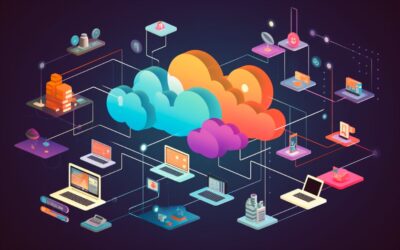Artificial intelligence (AI) has completely revolutionized the way we work. All teams can benefit from it—from human resources to internal communications and right on to the good folks in IT. Not surprisingly, AI is one of the key technology trends highlighted in Gartner’s latest report, Top Strategic Technology Trends 2024.
Gartner identified 10 tech trends in which to continue or start investing in 2024. What’s included? What impact will they have? And how can IT managers leverage them? Our analysis below!

- 1. AI Trust, Risk, and Safety Management (AI TRiSM)
- 2. Continuous Threat Exposure Management (CTEM)
- 3. Sustainable technology
- 4. Platform engineering
- 5. AI-augmented development
- 6. Industry cloud platforms
- 7. Intelligent applications
- 8. Democratized generative AI
- 9. Augmented connected workforce
- 10. Machine customers
1. AI Trust, Risk, and Safety Management (AI TRiSM)
Several technology trends for 2024 were already mentioned in Gartner’s 2023 report. These include AI Trust, Risk, and Security Management, also referred to as AI TRiSM. Its aim: to guarantee the reliability, transparency, and security of artificial intelligence models.
AI TRiSM allows you to:
- accelerate time to production of AI projects
- control cognitive biases better and make more accurate decisions
- test the explainability of AI models regularly (i.e., make their operation and results more transparent)

By 2026, this method should allow companies to eliminate 80% of erroneous or illicit information within their AI systems—and thus to make smarter decisions. To achieve this, they must:
- Create a team dedicated to TRiSM AI
- Effectively manage best-of-breed tools deployed in each department
- Define user charters and a system for automatically authorizing access to AI models
2. Continuous Threat Exposure Management (CTEM)
Continuous Threat Exposure Management (CTEM) is the second ongoing investment trend for 2024. It involves identifying, prioritizing, assessing, and managing cyber threats organizations face in order to minimize risk.
To implement it, Gartner recommends companies embark on the following initiatives:
- Integrate the CTEM approach into their cybersecurity awareness and risk management programs
- Improve prioritization of results using cyber risk assessment techniques
- Use the right cybersecurity solutions

Again, by 2026, organizations that adopt this approach should be able to reduce the number of security flaws hackers can exploit by two-thirds!
3. Sustainable technology
Corporate social responsibility (CSR) is playing an increasingly important role in organizations. That said, to implement CSR initiatives, you need the right digital tools! Here are a few ways:
- Draw up a roadmap in collaboration with your ethics and/or CSR committee
- Deploy the digital tools that will have the greatest impact in terms of sustainability (CSR diagnostic tools, collaborative solutions, cloud storage services, and more)
- Communicate on your CSR project internally. Take the opportunity to clarify your motives for implementing sustainable technology as well as the benefits it offers employees.
4. Platform engineering
Just like last year, platform engineering is one of the top technology trends to follow in 2024. In concrete terms, this refers to internal self-service platforms that deliver applications faster and improve developer teams’ productivity. Dedicated teams create and maintain each platform and can interface with different tools and processes to meet user needs.
By 2026, Gartner estimates that four out of five software engineering companies will use such teams to develop composable applications.
Not sure where to start? Here’s how to make this trend your own:
- Create in-house platforms with reusable components, tools, and services
- Ask your end users for their own feedback to help you identify the tools, processes, and technical capabilities that would be most useful on these platforms

5. AI-augmented development
Artificial intelligence can also help your software engineers create, test, and deploy new applications. For example, they can more quickly generate code and start to translate it into other programming languages. Thanks to AI, they can concentrate on higher value-added tasks like designing high-performance business applications.
Gartner’s report indicates that three out of four software engineers will have their own virtual assistants in 2028—and this when only one out of every 10 were using one in 2023! To keep up with this technological trend in 2024, you’ll need to:
- Build a team of senior software engineers capable of evaluating, deploying, and leveraging AI-based code generation tools
- Deploy AI tools for testing applications
- Establish a design system with reusable components for the user interface and front-end, to speed up the development process
- Empower non-technical employees: tools like no-code report builders have significantly lowered the barriers to technical work, enabling anyone, regardless of skill level, to extract valuable insights from databases
6. Industry cloud platforms
Technology trends for 2024 also include industry cloud platforms that combine SaaS (Software as a Service), PaaS (Platform as a Service) and IaaS (Infrastructure as a Service) services. This combination makes it possible to rapidly offer customized cloud platforms that each industry can then tailor to its own needs.
Today, fewer than 15% of all companies rely on such industry cloud platforms to accelerate their business development. By 2027, however, more than half are expected to implement them.
Here’s how you can deploy these platforms in your own organization:
- Use them to complement the application suite you already have in place (rather than replace all your existing applications).
- Create rules that clarify when industry cloud platforms are to be deployed and/or restructured, and for what purpose.
- Involve technical teams in the process and explain how they will contribute to the development of these composable platforms.

7. Intelligent applications
By 2026, 30% of new applications will use AI to create personalized, adaptive user interfaces.
These intelligent applications use AI coupled with data from transactions and external sources to push the right information to the right people and deliver an optimal user experience. They can offer personalized recommendations, enabling users to make data-driven decisions.
To develop these intelligent applications, companies will need to:
- Create a team to capture, explain, map, and evaluate the level of artificial intelligence to be integrated into your apps.
- Assess how intelligent applications can transform your business applications.
- Establish a shared understanding of what a smart app is and how they can be used.
- Analyze the impact on the entire portfolio of applications and services.
8. Democratized generative AI
Imagine using generative artificial intelligence to unleash your organization’s potential. This category of AI is capable of generating new content at breakneck speed—text, images, presentations, and even videos. The sky’s the limit!
By automating tasks linked to content production, generative AI boosts employee productivity and facilitates access to information. It’s arguably one of the most revolutionary tech trends for 2024.
By 2026, Gartner predicts that over 80% of companies will have already used or deployed generative AI applications, APIs, or models in production environments. Compared with today, the percentage of organizations using this technology is set to increase 16-fold!
To democratize use of generative AI, Gartner offers these suggestions:
- Create a matrix prioritizing generative AI use cases according to their technical feasibility and commercial value
- Define a deployment schedule for these use cases
- Implement a change management method that prioritizes training and team well-being
- Identify “quick wins” that deliver the most rapid returns on investment (ROI)
9. Augmented connected workforce
On a daily basis, your employees can use artificial intelligence to develop their skills and optimize the added value they deliver. Thanks to this man-machine collaboration, they can manage complex issues in record time.
By 2027, 25% of business leaders are expected to be implementing such initiatives. This would allow them to reduce the time needed to acquire new skills for strategic roles by 50%.
Here are Gartner’s pointers for forging a connected, augmented workforce:
- Prioritize skills development for workers with little experience who work in complex environments
- Set up a committee made up of the heads of each department (IT, HR, sales, customer service, and so forth) to prioritize your investments
- Develop an enhanced employee experience
- Create customized guides to help employees use AI tools responsibly
10. Machine customers
And if your customers became machines—would you be able to keep up with demand? Such is the question the trend towards machine customers, also known as custobots, has started to raise. Just like a normal customer, they’re capable of buying a product or service, negotiating a contract, or sharing their experience online. Except… well, they’re not humans. They’re machines.

By 2028, 15 billion connected products will be capable of behaving like customers, generating billions of dollars in sales.
To keep up with these technology trends, you’ll need to:
- Create a cross-functional research team dedicated to machine customers
- Develop one to three scenarios to explore market opportunities
- Design the data sources and API platform needed to serve machine customers (without using the digital interface you’ve created for your human customers).
A final word
Now that you know the main technology trends for 2024, it’s time to take action! Start by listing your company’s medium- and long-term objectives. Then identify the innovations that can help you achieve them, taking into account the resources at your disposal. The aim is not necessarily to follow all the trends described above, but rather to prioritize those that offer the best return on investment.
Think about the challenges you’re currently facing. What are your teams wasting the most time on? How can new types of technology solve this problem? Asking yourself these questions will help you decide which types of technology to deploy.
Wondering how to identify these challenges? Read our white paper on the challenges facing CIOs in the age of hybrid work:



